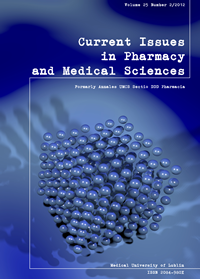Formulation and evaluation of sulfadimidine and trimethoprim tablets using wet granulation technique
DOI:
https://doi.org/10.12923/j.2084-980X/25.2/a.21Keywords:
dissolution, tablet excipients, sulphadimidine, trimethoprim, wet granulation, superdisintegrantAbstract
The objective of this study was to develop tablet formulations of sulphadimidine sodium (SDD-Na) and trimethoprim (TMP), evaluate and compare the efficiency of some excipients such as: superdisintegrant - croscarmellose sodium (Ac-Di-Sol), silicon dioxide (Aerosil), lactose and microcrystalline cellulose (Avicel pH-101) as base excipients for physical tablets properties and increasing the dissolution rate of SDD-Na and TMP. All tablet formulations were prepared by wet granulation process. Dissolution properties such as DP 30,45,60 (percent of drug dissolved at 30, 45 and 60 minutes), and dissolution rate constant value (K) were considered for comparing the dissolution results. The dissolution of SDD-Na and TMP from all examined tablet formulations followed Higuchi model kinetics with correlation coefficient (R) values from 0.984 to 0.995. The physical properties and in vitro drug release study revealed that tablets disintegration efficiency and drug dissolution depend on the amount of added disintegrant, the amount and presence of microcrystalline cellulose (Avicel) and lactose. Tablet formulation without addition of microcrystalline cellulose showed faster dissolution rate and shorter disintegration time as compared with that of tablets of formulations with microcrystalline cellulose. The results reveal that besides the type of diluents, the way of using superdisintegrant plays a major role in controlling disintegration of tablets. The portion of Ac-Di-Sol used as an intragranulary in the wet granulation process, is not as effective as that of the process of extragranulary addition. Tablets formulations F4 and F5 exhibited satisfactory friability, acceptable hardness, fulfilled the requirement for disintegration time for compressed tablets, and met the acceptable specifications with regard to drug release properties.
References
1. Accinelli C., Hashim M., Epifani R., Schneider R., Vicari A.: Effects of the antimicrobial agent sulfamethazine on metolachlor persistence and sorption in soil. Chemosphere. 63, 9, 1539-1545, 2006.
2. Akay C, Özkan S.A.: Simultaneous LC determination of trimethoprim and sulphamethoxazole in pharmaceutical formulations. J. Pharm. Biomed. Analysis 30, 4, 1207 – 1213, 2002.
3. Avachat A., Kotwal V.: Design and evaluation of matrix based controlled release tablets of diclofenac sodium and chondrotin sulphate. AAPS Pharm. Sci. Tech. 8, 4, 2007.
4. Balasubramaniam J., Bee T.: Influence of superdisintegrants of the rate of drug dissolution from oral solid dosage forms. Pharm. Tech. Apr. 1, 2009.
5. Gao J., Jain, A., Motheram R., Gray D.B., Hussain M.A.: Fluid bed granulation of a poorly water soluble, low density, micronized drug: comparison with high shear granulation. Int. J. Pharm. 237, 1, 2002.
6. Gohel MC et al.: Improving the tablet characteristics and dissolution profile of ibuprofen by using novel coprocessed superdisintegrant. AAPS Pharm. Sci. Tech. 8 1, 2007.
7. Gordon M.S., Rudraraju V.S., Dani K., Chowan Z.T.: Effect of the mode of super disintegrant incorporation on dissolution in wet granulated tablets. J. Pharm. Sci. 82, 220, 1993. Published online: 21 SEP 2006.
8. Guneysel O., Onur O., Erdede M., Denizbasi A.: Trimethoprim/Sulfamethoxazole Resistance in Urinary Tract Infections. J. Emerg. Med. 36, 4, 338, 2009.
9. Kasperek R., Czarnecki W.: Effect of hydrophilic substances on liberation of quinidine from starch - alginate sphere. Acta Pol. Pharm. 58, 2, 107, 2001.
10. Late S.G., Tu Y., Banga A.K.: Effects of disintegration-promoting agent, lubricants and moisture treatment on optimized fast disintegrating tablets. Int. J. Pharm. 365, 4, 2009.
11. López-Martínez L., Lopez-de-Alba P.L., de-Leon-Rodriguez L.M., Yepez-Murrietta L.: Simultaneous determination of binary mixtures of trimethoprim and sulfamethoxazole or sulphamethoxypyridazine by the bivariate calibration spectrophotimetric method. J. Pharm. Biomed. Anal. 30,77, 2002.
12. Moreno Gálvez, A., García Mateo J. V., Martínez Calatayud, J.: Simultaneous dissolution profiles of two drugs, sulfadiazine-trimethoprim and amitriptyline-perphenazine, in solid oral dosage forms by a FIA manifold provided with a single spectrophotometric detector. J. Pharm. Biomed. Anal. 30, 3, 535, 2002.
13. Ousama R. , Dévay A., Saeed A.: AAPS Pharm. Sci. Tech.: Dissolution Testing of Sublingual Tablets: A Novel In Vitro Method 12, 2, 2011.
14. Papapanagiotou E.P., Fletouris D.J., Psomas I.E.: Sulphamethazine residue depletion study in piglets after oral administration. Analytica Chimica Acta 529, 325, 2005.
15. Yuqi L., Xin L., Dong Y., Cunku J., Jingyao Q.: Selective recognition of veterinary drugs residues by artificial antibodies designed using a computational approach. Biomaterials 30, 18, 3205, 2009.
16. Zimmer Ł., Belniak P., Szopa A., Poleszak E.: Superdisintegrants in new solid dosage forms - a review. Ann. UMCS, Sect. DDD, 24, 2, 75, 2011.
17. Zimmer Ł., Czarnecki W.: Derivative specrtrophotometric method for simultaneous determination of sulfadimidine and trimethoprim. Ann. UMCS, Sect. DDD, 23, 1, 27, 2010.
18. Zimmer Ł., Czarnecki W.: Influence of egg albumin on vitamin E release from gelatin capsules. Ann. UMCS, Sect. DDD, 22, 3, 73, 2009.
Downloads
Published
Issue
Section
License
Copyright (c) 2012 Authors

This work is licensed under a Creative Commons Attribution-NonCommercial-NoDerivatives 3.0 Unported License.


